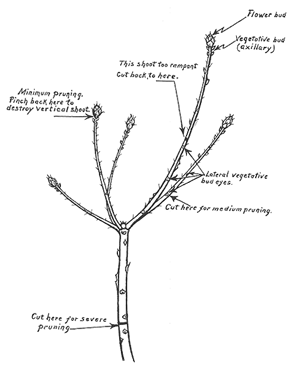
| Volume XVII, Issue 15 - April 9 - April 15, 2009 |

Pruning and Shaping Azaleas
Cut away; they’ll come back like gangbusters
 While doing a pruning demonstration recently, I was asked how you shorten azalea plants that are too big. The people attending the demonstration were most surprised when I told them to cut the plants 12 to 18 inches below the desired height as soon as the petals start wilting.
While doing a pruning demonstration recently, I was asked how you shorten azalea plants that are too big. The people attending the demonstration were most surprised when I told them to cut the plants 12 to 18 inches below the desired height as soon as the petals start wilting.
Most home gardeners are accustomed to only lightly pruning azaleas, rhododendrons and mountain laurel for fear of killing their plants. Azaleas can actually be cut down to the ground in the spring; they will come back like gangbusters in July. Prune azaleas down to stems that are almost an inch in diameter and they will generate sprouts up and down that stem within three to four weeks. The stems of azalea plants are loaded with latent buds, and the stems are also capable of generating adventitious buds. Latent buds are vegetative buds that were produced when that stem had leaves attached. Adventitious buds are vegetative buds that are produced at or near the cut surface made at the time of pruning.
If you are going to prune back azaleas, rhododendrons and mountain laurel severely, do it before flowering if possible and avoid fertilizing them for at least one year. If you can tolerate not having azaleas flowers for a year, the earlier you prune back, the earlier the plant will generate new growth. Delaying severe pruning until after flowering may result in no signs of new growth until late-May to mid-June.
When a plant is severely pruned back, its large underground root system is well prepared to supply water and nutrients to all of the original branches you have removed. By delaying fertilizing until the second year of growth, the root system has time to adjust to a lesser amount of top growth. Fertilizing a severely pruned plant can often result in fertilizer burn to the roots.
By pruning the plant 12 to 18 inches below the desired height, you will allow space for training the new growth to the height and shape you seek.
Really? Yes!
Q My azaleas did not fare well against the deer. I doubt if I’ll have a bloom. Some bushes are just twigs. Most have a few empty stems and some with leaves at the center. Should I just prune each branch or whack the worst ones down almost completely and let them grow back? Should I go ahead and put Holly Tone on them now to start some growth since they aren’t going to bloom anyway?
A If the plants are overgrown, whack them back hard and let them bush out, then renew the training program. If the plants still have room to grow, prune back to individual branches. Don’t fertilize until after the plants have resumed growth, sometime in early to mid-June. Plants that have been severely pruned should not be fertilized until after they have put out a flush of growth.